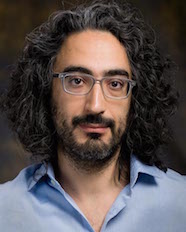Reza Vafabakhsh Associate Professor
Research Summary:
The Reza Lab uses quantitative microscopy and chemical biology tools to study the dynamics of proteins and how spatial and temporal organization within cells is achieved. Currently, there are two main research directions in the lab: (1) We use single-molecule spectroscopy and biophysical and biochemical methods to study the conformational dynamics of membrane proteins that are responsible for their activation and modulation, with the aim of finding new ways to therapeutically target these proteins. Many projects in the lab have focused on G protein-coupled receptors (GPCRs) and ion channels. (2) We use microscopy, cell biology and soft matter methodologies investigate how membranelles organelles in cells are assembled, maintained, and reorganized.
Selected Publications:
Middle-Down Mass Spectrometry Reveals Activity-Modifying Phosphorylation Barcode in a Class C G Protein-Coupled Receptor, Ashley N. Ives, Henry A. Dunn, Hamid Samareh Afsari, Henrique dos Santos Seckler, Max J. Foroutan, Erica Chavez, Rafael D. Melani, Ryan T. Fellers, Richard D. LeDuc, Paul M. Thomas, Kirill A. Martemyanov, Neil L. Kelleher, and Reza Vafabakhsh, JACS, 144, 50, 23104–23114 (2022).
Conformational fingerprinting of allosteric modulators in metabotropic glutamate receptor 2, Brandon Wey-Hung Liauw, Arash Foroutan, Michael R Schamber, Weifeng Lu, Hamid Samareh Afsari, Reza Vafabakhsh, eLife, e78982 (2022).
Mechanism of sensitivity modulation in the calcium-sensing receptor via electrostatic tuning, Michael R. Schamber & Reza Vafabakhsh, Nature Communications, 13, 2194 (2022).
Conformational rearrangement during activation of a metabotropic glutamate receptor, Brandon Wey-Hung Liauw, Hamid Samareh Afsari and Reza Vafabakhsh, Nature Chemical Biology, 17, 291–297 (2021).
Conformational dynamics of a class C G-protein-coupled receptor, Vafabakhsh R, Levitz J, and Isacoff EY. Nature. 524(7566):497-501 (2015).
